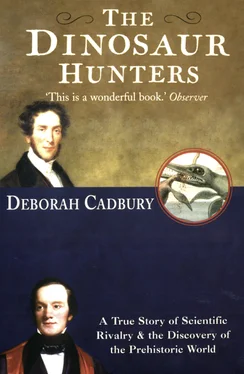As news of Mary Anning’s finds spread among the members of the Geological Society several gentlemen, as well as William Buckland, sought her out at Lyme. She was cultivated by Henry de la Beche, who was studying the Ichthyosaurus with Reverend Conybeare. De la Beche was a young man of independent means who had inherited from his father an estate in Jamaica, which had prospered with the slavery trade. A Lieutenant-Colonel Thomas Birch also took a keen interest in gathering fossil evidence of the Ichthyosaurus, and acquired many of her specimens. Anna Pinney noted that Mary was ‘courted by those above her’, and she rapidly acquired ‘many ideas and a power of communicating them’. In spending time with such gentlemen from a very different class, she had already stepped aside from her peasant background. ‘She frankly owns,’ admitted Anna, ‘that the society of her own rank is become distasteful to her.’ Despite this, she continued to ‘attend the sick poor night and day, even when they are ill with infectious diseases’. Whether Mary dared to hope that one day she might escape hardships of her upbringing through marriage is not recorded.
She became a familiar figure on the shoreline, variously portrayed in her long skirts and shawl, clogs, poke-bonnet or hat, a lone figure endlessly toiling at her mysterious task against vast skies and shifting tides. Such was her dedication, Anna Pinney wrote, that she continued ‘to support her mother and brother in bitter poverty even when she was so ill that she was brought … fainting from the beach’.
The layers of rock that so fascinated Mary Anning held the secrets of prehistory. Locked behind the impenetrable dark face of Black Ven and the cliffs beyond were the clues to an ancient ocean, whose boundaries were yet unknown. From her discussions with the gentlemen geologists, Mary knew that another kind of sea lizard was almost certainly buried there, waiting to be uncovered.
There is no picking up a pebble by the brook side without finding all nature in connexion with it.
Cited in Thoughts on a Pebble by Gideon Mantell, 1849
While Mary Anning was searching the shore for fossils, a young shoemaker’s son, Gideon Algernon Mantell, was trying to make his own way in the world of science. A story told by one of his childhood companions reveals that, like Buckland, Gideon Mantell was drawn to geology early in life:
As a mere youth, he was walking with a friend on the banks of the River Ouse when his observant eye rested on an object which had rolled down the marly bank … He dragged it from the water and examined it with great attention. ‘What is it?’ inquired his friend. ‘I think that it is what they call “a fossil”,’ he replied. ‘I have seen something like it in an old volume of the Gentleman’s Magazine.’ The curiosity, which proved to be a fine specimen of Ammonite, was borne home in triumph … and from that moment young Mantell became a geologist.
It was a revelation to Mantell that buried in the earth beneath their feet lay the ‘wreckage of former lives that had turned to stone’. His home town of Lewes in Sussex is enveloped by the dramatic contours of the chalk South Downs. Past the grammar school, the castle and the Market House, the High Street plunged towards the valley of the River Ouse and the chalk spur beyond loomed above the smoke from the chimneys of the shops. To the south, past the ruined priory, the green fields, decked with white wherever the chalk broke through the thin covering of grass, beckoned Mantell through every cobbled alley-way.
As a child exploring the local pits and quarries he uncovered ammonites with their coils ‘like the fabled horn of Jupiter, Ammon’, and shells with spines, such as the sea urchin, and the remains of corals and fishes; the chalk hills teemed with the worn relics of creatures that had lived long ago. For the young Mantell, science was ‘like the fabled wand of the magician’ which could ‘call forth from the stone and from the rock their hidden lore and reveal the secrets they have so long enshrined’. Every fossil reclaimed from the past was, for him, a ‘medal of creation’, a fantastic page of Nature’s volume to interpret.
Far removed from his vision of ancient worlds was the daily reality of supplying the town’s footwear. He and his six brothers and sisters were brought up in a cottage in St Mary’s Lane, a steep, narrow road that ran off the High Street. At a time when social status was principally determined by money and land, Gideon Mantell was aware of his family’s modest station in life. Although his father, Thomas, ran a successful business, sometimes employing several people, he was a ‘tradesman’, not a ‘gentleman’, and so excluded from the higher ranks of society.
It was a far cry from what Mantell understood of the great wealth of the family’s forebears. In his youth, he dreamed of restoring the family honours. He told a friend, ‘although my parents and their immediate predecessors were in comparatively humble stations, being only trades people in a country town, yet they were descendants of one of the most ancient families in England. The name “Mantell” occurs in the list of Knights that accompanied William the Conqueror from Normandy. The family settled in Northamptonshire and possessed large manors at Heyford and Rode where many of the family bore the honor of a Knighthood.’
But the family fortunes had been lost almost overnight. The grandson of Sir Walter Mantell, a Protestant, took part in Sir Thomas Wyatt’s attempt in 1554 to prevent the Catholic marriage of Queen Mary with Philip of Spain. The planned royal marriage was so unpopular that Wyatt and an array of four thousand men almost reached London Bridge before they were outnumbered and eventually forced to surrender. Wyatt and the ringleaders, including Mantell and his grandson, were executed. As if this was not enough, all the Mantell family estates, in Kent, Sussex and Northamptonshire, were forfeited to the Crown. ‘Irretrievable ruin fell upon the house,’ wrote Gideon Mantell; ‘in my boyish days I fancied I should restore its honors and that my children would have obtained the distinctions our knightly race once bore.’
Mantell’s soaring ambitions were not without foundation, for he was regarded as something of a child prodigy in his home town. He was distinguished by ‘uncommon perseverance and quickness in his studies’. Owing to his pious parents, ‘his retentive memory enabled him when young to repeat a large part of the Bible by heart’. When older, he was described in local records as ‘tall and graceful’, and with a ‘style of brilliancy and eloquence’. A painting of him in his youth shows a handsome face, with even, expressive features and dark hair and eyes. Whether this is a truthful portrait is unknown, but according to the Sussex Gazette he was not lacking in charisma: ‘He had the attractive personality of an actor, a voice of great power, and with clear enunciation and pleasing musical cadences he could hold his listeners spellbound.’
But as the son of a bootmaker, the young Gideon Mantell was educated with great frugality. Because of his father’s nonconformist beliefs as a Methodist, the six children were excluded from the local grammar school; the twelve free places each year were reserved for those brought up in the Anglican faith. Instead, Gideon was sent to the dame-school among the labourers’ cottages in St Mary’s Lane. Here, under the simple guidance of an old woman, he was taught the rudiments of reading and writing in her front parlour, and he became so great a favourite that on her death the teacher left Gideon everything she had. After this, he went to the school of a Mr John Button, an exuberant philosophical radical, ‘where a sound and practical commercial education was given by a gentleman whose political sentiments were so accordant with those of Gideon Mantell’s father, that he was known to be on the Government black list’.
Читать дальше












